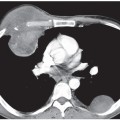CASE 112 55-year-old man with progressive dyspnea on exertion Contrast-enhanced chest CT (lung window, Figs. 112.1A, 112.1C, 112.1E; mediastinal window, Figs. 112.1B, 112.1D, 112.1F) demonstrates interlobular septal and fissural thickening and calcification, juxtapleural and pleural calcification, and profuse micronodular calcifications throughout both lungs. Note the preferential involvement of the peripheral secondary pulmonary lobule, producing sharply defined polygonal calcific opacities. Pulmonary Alveolar Microlithiasis (PAM) • Amyloidosis (diffuse septal form) • Granulomatous Infection • Sarcoidosis (micronodules more profuse in upper lobes; rarely calcify) • Silicosis (micronodules more profuse in upper lobes) • Talcosis (upper lobe nodules; aggregate into perihilar masses) • Metastatic Ossification Chronic Renal Failure (calcifications larger; less well defined) • Idiopathic Ossification (elderly men; calcifications not as pronounced) Pulmonary alveolar microlithiasis (PAM) is a rare disorder characterized by accumulation of calcium phosphate calcospherites within the alveolar spaces. The etiology is unknown. A familial occurrence (autosomal recessive) has been noted in approximately 50% of reported cases.
 Clinical Presentation
Clinical Presentation
 Radiologic Findings
Radiologic Findings
 Diagnosis
Diagnosis
 Differential Diagnosis
Differential Diagnosis
 Miliary Tuberculosis
Miliary Tuberculosis
 Disseminated Fungal Disease
Disseminated Fungal Disease
 Discussion
Discussion
Background
Etiology
Clinical Findings
Stay updated, free articles. Join our Telegram channel

Full access? Get Clinical Tree





